2022 TOYOTA COROLLA roof
[x] Cancel search: roofPage 4 of 678

2TABLE OF CONTENTS
For your information ........................6
Reading this manual........................ 9
How to search ............................... 10
Pictorial index ................................ 11
1-1. For safe use
Before driving........................ 28
For safe driving ..................... 29
Seat belts .............................. 31
SRS airbags.......................... 35
Exhaust gas precautions ...... 43
1-2. Child safety
Airbag manual on-off system
............................................ 45
Riding with children............... 46
Child restraint systems ......... 47
1-3. Emergency assistance
eCall...................................... 64
1-4. Theft deterrent system
Engine immobilizer system ... 74
Double locking system .......... 75
Alarm .................................... 76
2-1. Instrument cluster
Warning lights and indicators
............................................ 80
Gauges and meters (4.2-inch
display) ............................... 85
Gauges and meters (7-inch dis-
play) .................................... 88
Multi-information display ....... 93
Head-up display .................. 100
Fuel consumption information
.......................................... 104
3-1. Key information
Keys .................................... 108
3-2. Opening, closing and locking
the doors
Doors .................................. 113
Trunk................................... 118
Smart entry & start system
.......................................... 121
3-3. Adjusting the seats
Front seats .......................... 126
Rear seats .......................... 127
Head restraints ................... 128
3-4. Adjusting the steering wheel
and mirrors
Steering wheel .................... 131
Inside rear view mirror ........ 132
Outside rear view mirrors.... 133
3-5. Opening and closing the win-
dows
Power windows ................... 136
Moon roof............................ 139
4-1. Before driving
Driving the vehicle .............. 145
Cargo and luggage ............. 152
Trailer towing (for M15A-FKS
engine).............................. 153
Trailer towing (except for
M15A-FKS engine) ........... 158
1For safety and security
2Vehicle status information
and indicators
3Before driving
4Driving
Page 10 of 678
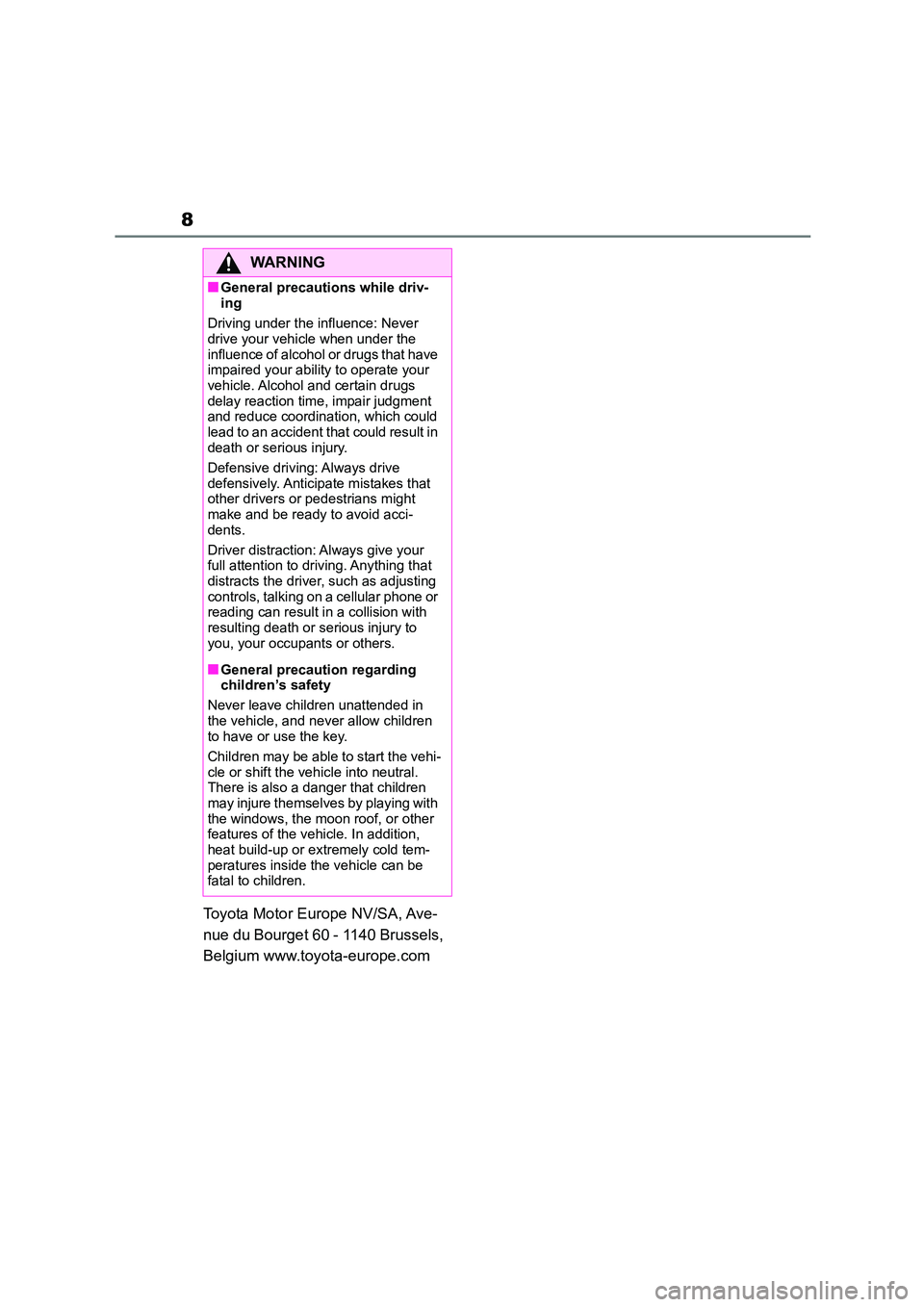
8
Toyota Motor Europe NV/SA, Ave-
nue du Bourget 60 - 1140 Brussels,
Belgium www.toyota-europe.com
WA R N I N G
■General precautions while driv-
ing
Driving under the influence: Never drive your vehicle when under the
influence of alcohol or drugs that have
impaired your ability to operate your vehicle. Alcohol and certain drugs
delay reaction time, impair judgment
and reduce coordination, which could
lead to an accident that could result in death or serious injury.
Defensive driving: Always drive
defensively. Anticipate mistakes that other drivers or pedestrians might
make and be ready to avoid acci-
dents.
Driver distraction: Always give your
full attention to driving. Anything that
distracts the driver, such as adjusting controls, talking on a cellular phone or
reading can result in a collision with
resulting death or serious injury to you, your occupants or others.
■General precaution regarding children’s safety
Never leave children unattended in
the vehicle, and never allow children to have or use the key.
Children may be able to start the vehi-
cle or shift the vehicle into neutral. There is also a danger that children
may injure themselves by playing with
the windows, the moon roof, or other features of the vehicle. In addition,
heat build-up or extremely cold tem-
peratures inside the vehicle can be fatal to children.
Page 21 of 678
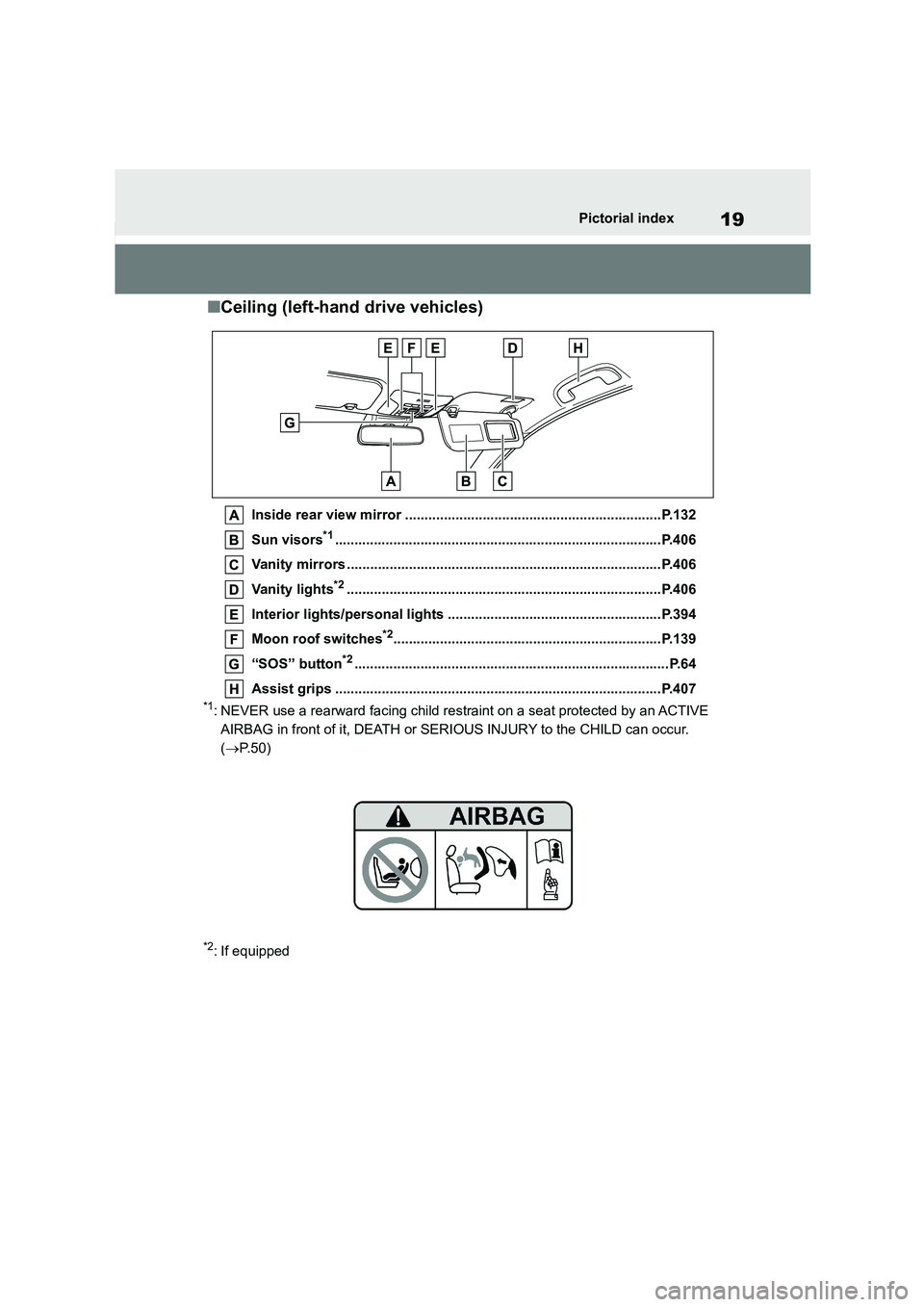
19Pictorial index
■Ceiling (left-hand drive vehicles)
Inside rear view mirror ..................................................................P.132
Sun visors*1....................................................................................P.406
Vanity mirrors .................................................................................P.406
Vanity lights*2.................................................................................P.406
Interior lights/personal lights .......................................................P.394
Moon roof switches*2.....................................................................P.139
“SOS” button*2.................................................................................P.64
Assist grips ....................................................................................P.407
*1: NEVER use a rearward facing child restraint on a seat protected by an ACTIVE
AIRBAG in front of it, DEATH or SERIOUS INJURY to the CHILD can occur.
( P. 5 0 )
*2: If equipped
Page 27 of 678
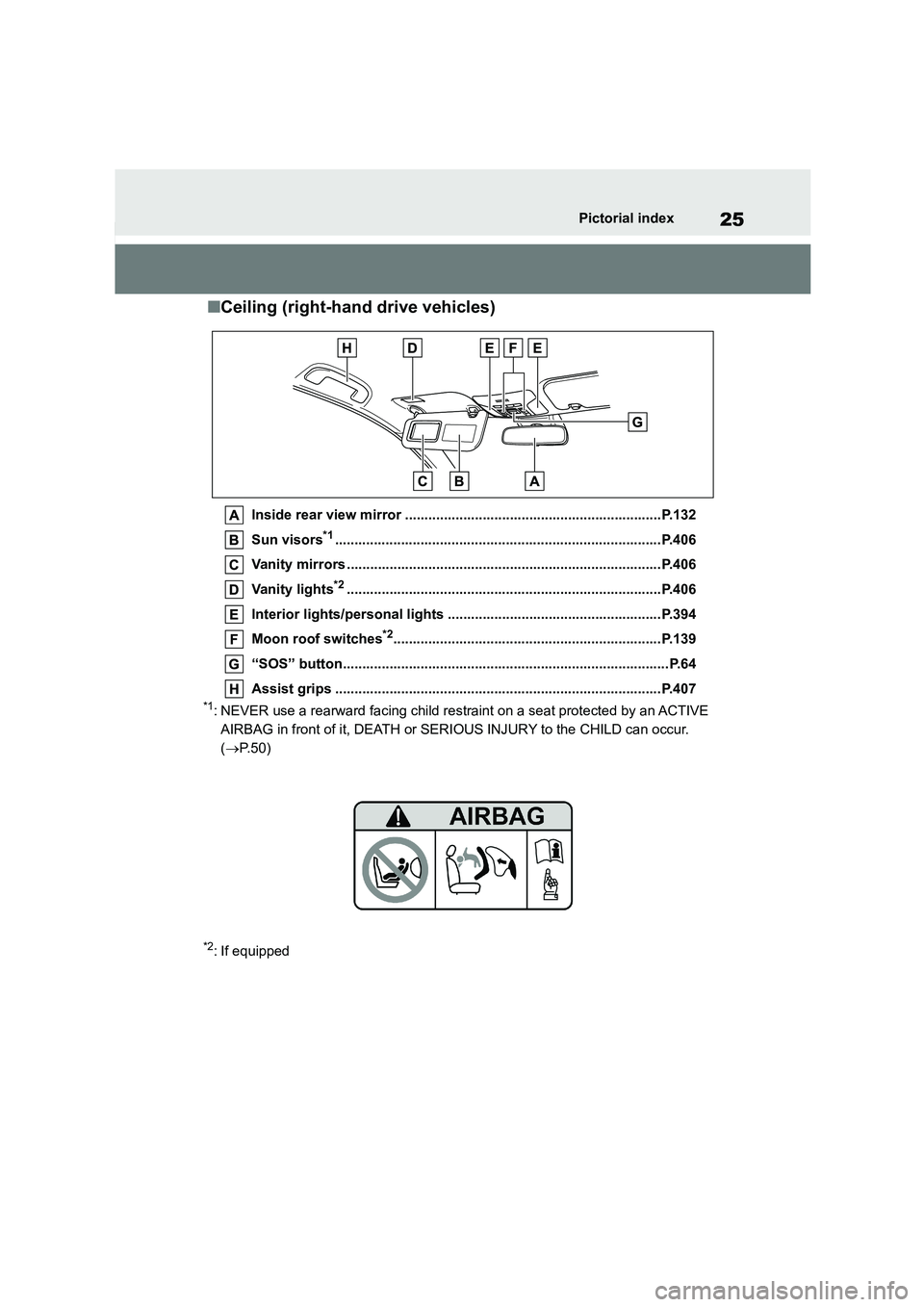
25Pictorial index
■Ceiling (right-hand drive vehicles)
Inside rear view mirror ..................................................................P.132
Sun visors*1....................................................................................P.406
Vanity mirrors .................................................................................P.406
Vanity lights*2.................................................................................P.406
Interior lights/personal lights .......................................................P.394
Moon roof switches*2.....................................................................P.139
“SOS” button....................................................................................P.64
Assist grips ....................................................................................P.407
*1: NEVER use a rearward facing child restraint on a seat protected by an ACTIVE
AIRBAG in front of it, DEATH or SERIOUS INJURY to the CHILD can occur.
( P. 5 0 )
*2: If equipped
Page 39 of 678

37
1
1-1. For safe use
For safety and security
may be sustained from SRS airbags,
due to the extremely high speed deployment (inflation) by hot gases.
●A loud noise and white powder will be emitted.
●Parts of the airbag module (steering wheel hub, airbag cover and inflator)
as well as the front seats, parts of the
front and rear pillars, and roof side rails, may be hot for several minutes.
The airbag itself may also be hot.
●The windshield may crack.
●The brakes and stop lights will be con- trolled automatically. ( P.316)
●The interior lights will turn on automat- ically. ( P.395)
●The emergency flashers will turned on automatically. ( P.462)
●Fuel supply to the engine will be stopped. ( P.470)
●Vehicles with eCall: If any of the fol-
lowing situations occur, the system is
designed to send an emergency call*
to the eCall control center, notifying
them of the vehicle’s location (without needing to push the “SOS” button)
and an agent will attempt to speak
with the occupants to ascertain the level of emergency and assistance
required. If the occupants are unable
to communicate, the agent automati- cally treats the call as an emergency
and helps to dispatch the necessary
emergency services. ( P. 6 4 ) • An SRS airbag is deployed.
• A seat belt pretensioner is activated.
• The vehicle is involved in a severe rear-end collision.*: In some cases, the call cannot be
made. ( P. 6 5 )
■SRS airbag deployment conditions (SRS front airbags)
●The SRS front airbags will deploy in the event of an impact that exceeds
the set threshold le vel (the level of
force corresponding to an approxi- mately 20 - 30 km/h [12 - 18 mph]
frontal collision with a fixed wall that
does not move or deform).
However, this threshold velocity will be
considerably higher in the following situ-
ations: • If the vehicle strikes an object, such
as a parked vehicle or sign pole,
which can move or deform on impact • If the vehicle is involved in an
underride collision, such as a collision
in which the front of the vehicle “underrides”, or goes under, the bed
of a truck
●Depending on the type of collision, it is
possible that only the seat belt
pretensioners will activate.
■SRS airbag deployment conditions (SRS side and curtain shield
airbags [if equipped])
●The SRS side and curtain shield
airbags will deploy in the event of an
impact that exceeds the set threshold level (the level of force corresponding
to the impact force produced by an
approximately 1500 kg [3300 lb.] vehi- cle colliding with the vehicle cabin
from a direction perpendicular to the
vehicle orientation at an approximate speed of 20 - 30 km/h [12 - 18 mph]).
●Vehicles with an SRS driver’s knee airbag: Both SRS curtain shield
airbags may deploy in the event of a
severe side collision.
●Both SRS curtain shield airbags may
also deploy in the event of a severe frontal collision.
■Conditions under which the SRS
airbags may deploy (inflate), other
than a collision
The SRS front airbags and SRS side
and curtain shield airbags may also
deploy if a serious impact occurs to the
underside of your vehicle. Some exam- ples are shown in the illustration.
●Hitting a curb, edge of pavement or hard surface
●Falling into or jumping over a deep hole
●Landing hard or falling
Page 41 of 678
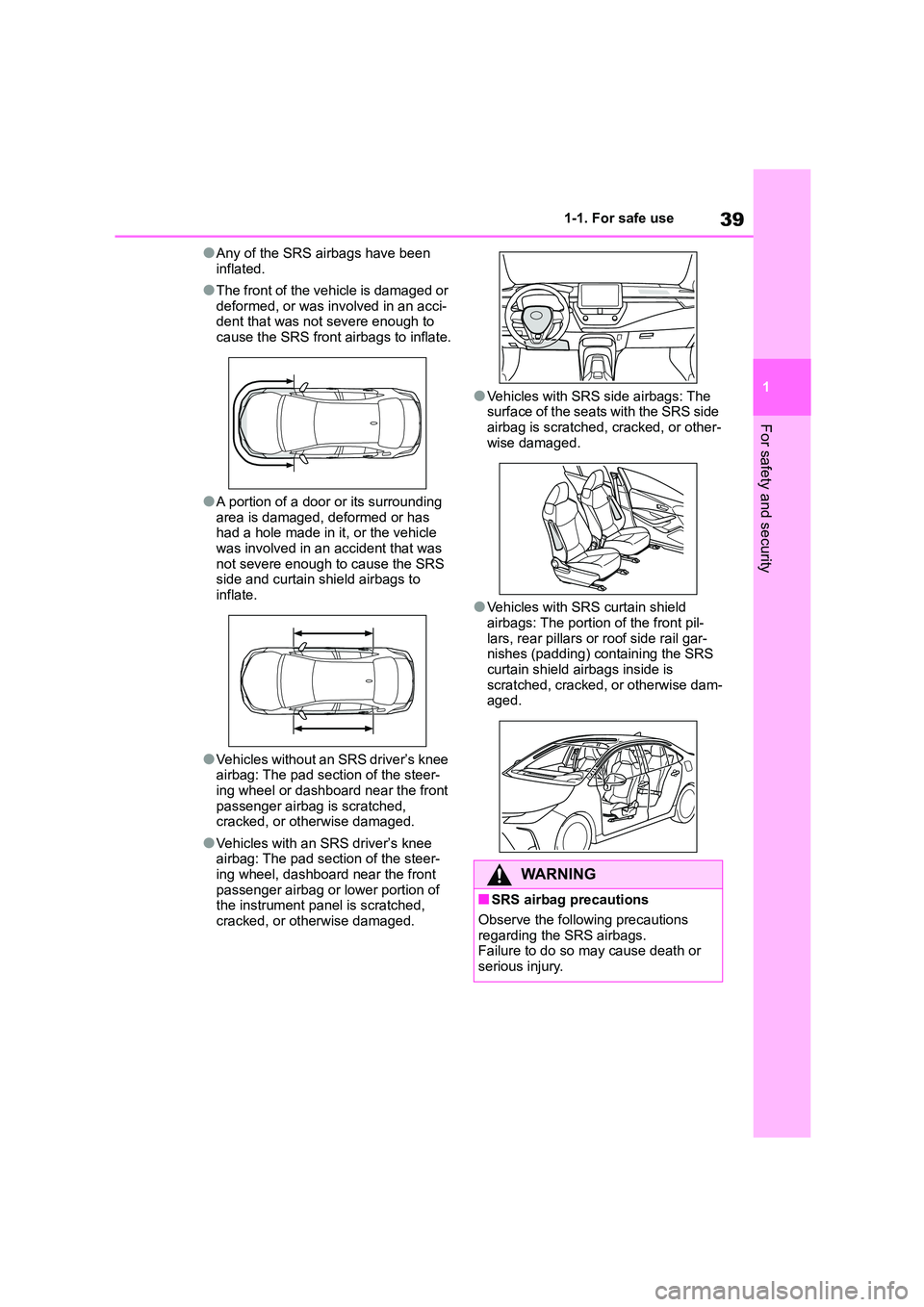
39
1
1-1. For safe use
For safety and security
●Any of the SRS airbags have been
inflated.
●The front of the vehicle is damaged or
deformed, or was involved in an acci- dent that was not severe enough to
cause the SRS front airbags to inflate.
●A portion of a door or its surrounding
area is damaged, deformed or has
had a hole made in it, or the vehicle was involved in an accident that was
not severe enough to cause the SRS
side and curtain shield airbags to inflate.
●Vehicles without an SRS driver’s knee airbag: The pad section of the steer-
ing wheel or dashboard near the front
passenger airbag is scratched, cracked, or otherwise damaged.
●Vehicles with an SRS driver’s knee airbag: The pad section of the steer-
ing wheel, dashboard near the front
passenger airbag or lower portion of the instrument panel is scratched,
cracked, or otherwise damaged.
●Vehicles with SRS side airbags: The
surface of the seats with the SRS side airbag is scratched, cracked, or other-
wise damaged.
●Vehicles with SRS curtain shield
airbags: The portion of the front pil-
lars, rear pillars or roof side rail gar- nishes (padding) containing the SRS
curtain shield airbags inside is
scratched, cracked, or otherwise dam- aged.
WA R N I N G
■SRS airbag precautions
Observe the following precautions
regarding the SRS airbags. Failure to do so may cause death or
serious injury.
Page 43 of 678
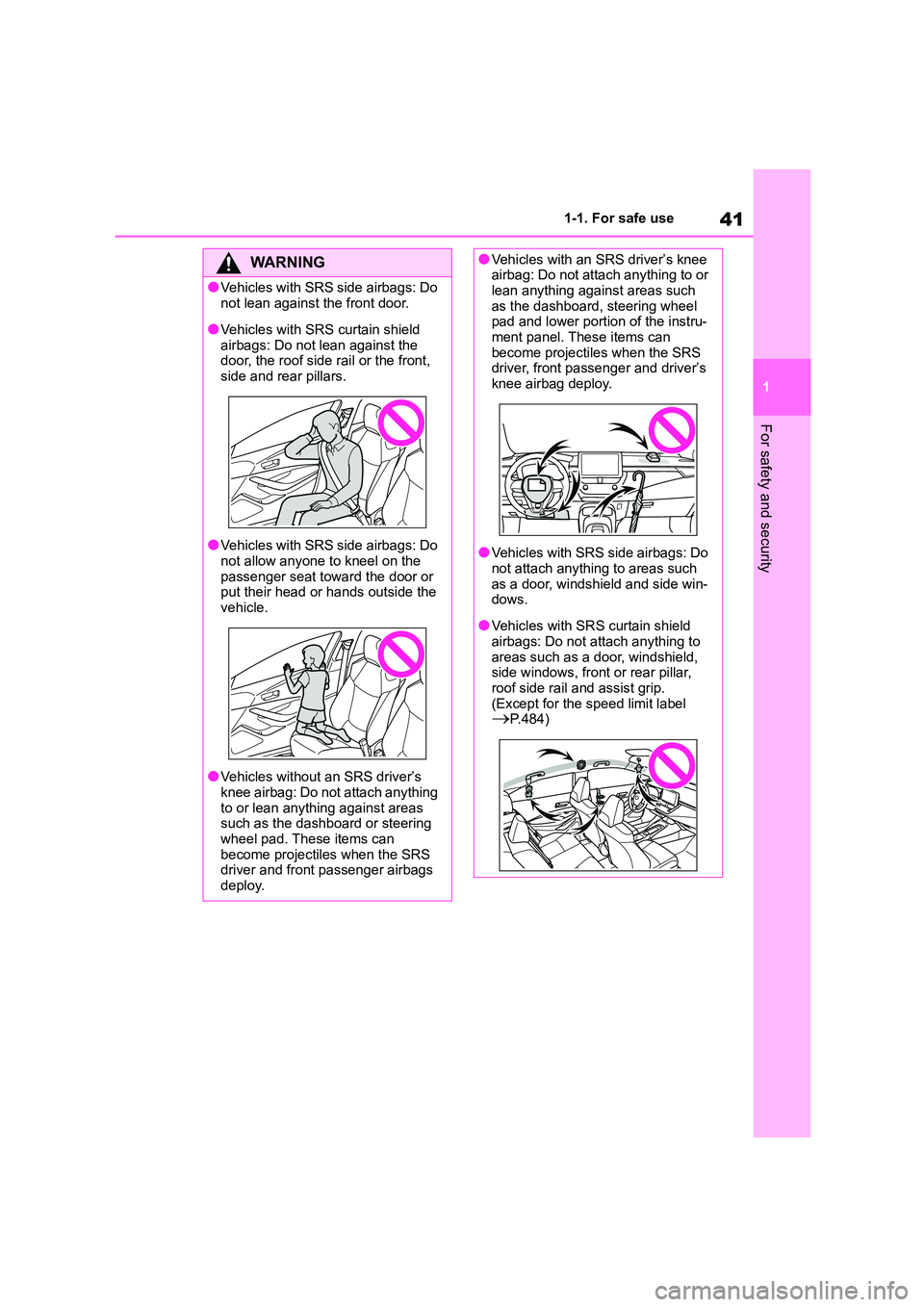
41
1
1-1. For safe use
For safety and security
WA R N I N G
●Vehicles with SRS side airbags: Do
not lean against the front door.
●Vehicles with SRS curtain shield
airbags: Do not lean against the
door, the roof side rail or the front, side and rear pillars.
●Vehicles with SRS side airbags: Do
not allow anyone to kneel on the passenger seat toward the door or
put their head or hands outside the
vehicle.
●Vehicles without an SRS driver’s
knee airbag: Do not attach anything to or lean anything against areas
such as the dashboard or steering
wheel pad. These items can become projectiles when the SRS
driver and front passenger airbags
deploy.
●Vehicles with an SRS driver’s knee airbag: Do not attach anything to or
lean anything against areas such
as the dashboard, steering wheel pad and lower portion of the instru-
ment panel. These items can
become projectiles when the SRS driver, front passe nger and driver’s
knee airbag deploy.
●Vehicles with SRS side airbags: Do
not attach anything to areas such
as a door, windshield and side win- dows.
●Vehicles with SRS curtain shield airbags: Do not attach anything to
areas such as a door, windshield,
side windows, front or rear pillar, roof side rail and assist grip.
(Except for the speed limit label
P.484)
Page 45 of 678
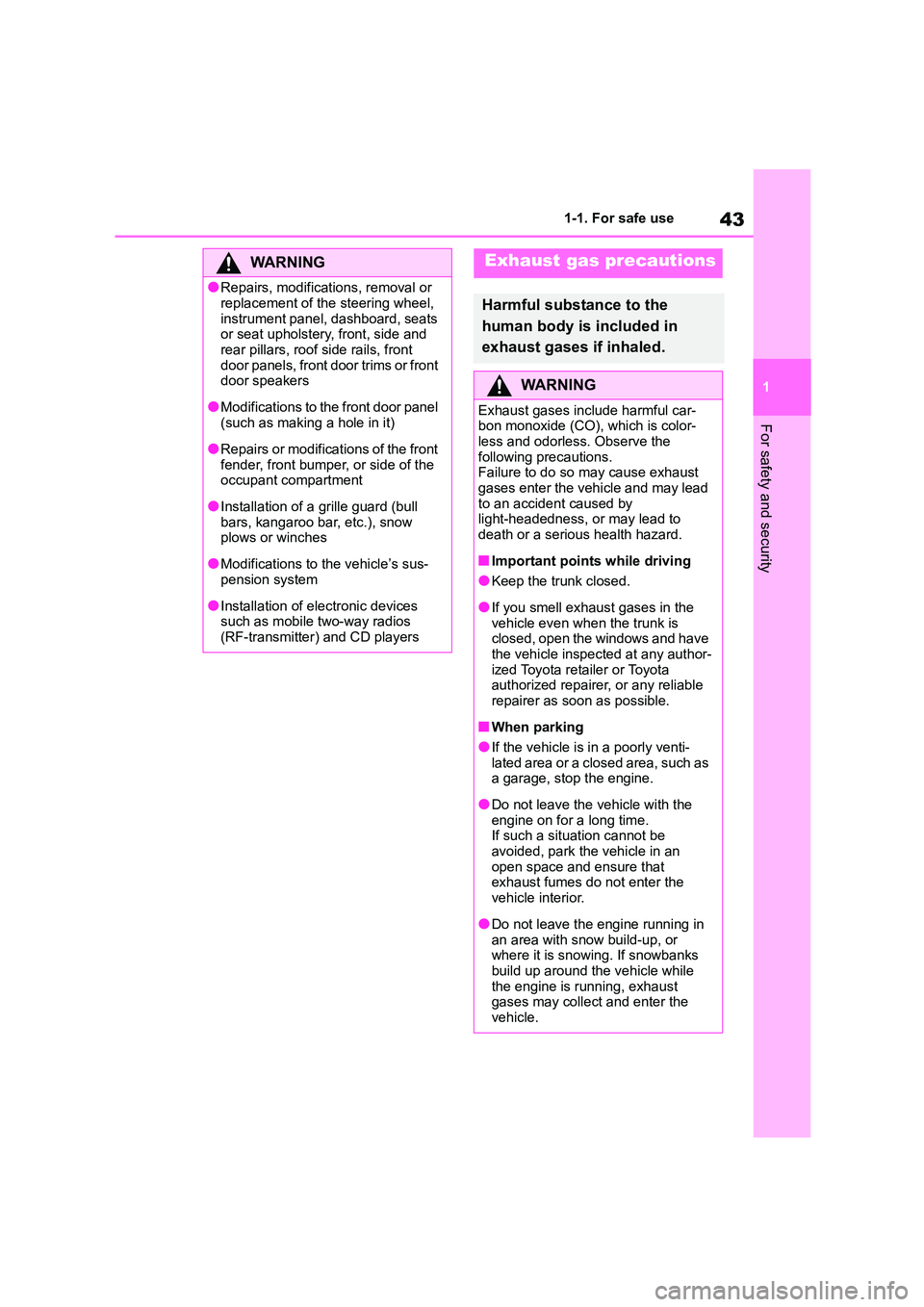
43
1
1-1. For safe use
For safety and security
WA R N I N G
●Repairs, modifications, removal or
replacement of the steering wheel,
instrument panel, dashboard, seats or seat upholstery, front, side and
rear pillars, roof side rails, front
door panels, front door trims or front door speakers
●Modifications to the front door panel
(such as making a hole in it)
●Repairs or modifications of the front
fender, front bumper, or side of the occupant compartment
●Installation of a grille guard (bull bars, kangaroo bar, etc.), snow
plows or winches
●Modifications to the vehicle’s sus-
pension system
●Installation of electronic devices
such as mobile two-way radios
(RF-transmitter) and CD players
Exhaust gas precautions
Harmful substance to the
human body is included in
exhaust gases if inhaled.
WA R N I N G
Exhaust gases include harmful car-
bon monoxide (CO), which is color-
less and odorless. Observe the following precautions.
Failure to do so may cause exhaust
gases enter the vehicle and may lead to an accident caused by
light-headedness, or may lead to
death or a serious health hazard.
■Important points while driving
●Keep the trunk closed.
●If you smell exhaust gases in the
vehicle even when the trunk is closed, open the windows and have
the vehicle inspected at any author-
ized Toyota retailer or Toyota authorized repairer, or any reliable
repairer as soon as possible.
■When parking
●If the vehicle is in a poorly venti-
lated area or a closed area, such as a garage, stop the engine.
●Do not leave the vehicle with the engine on for a long time.
If such a situation cannot be
avoided, park the vehicle in an open space and ensure that
exhaust fumes do not enter the
vehicle interior.
●Do not leave the engine running in
an area with snow build-up, or where it is snowing. If snowbanks
build up around the vehicle while
the engine is running, exhaust gases may collect and enter the
vehicle.